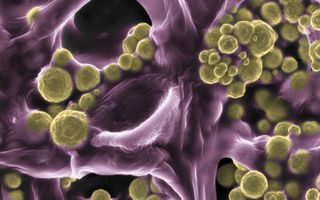This Fungus Mines For Gold, Then Wears It

Fungus now has a gold standard.
A pink, fluffy fungus found around the world is literally a gold-digger, collecting particles of precious gold along the thread-like strands that it extends into soil, scientists just discovered.
The gold-crusted fungus, called Fusarium oxysporum, doesn't just look fancy; it also seems to benefit from the bling, spreading faster and growing larger than unadorned fungi, researchers reported in a new study. [Microscopic Worlds Gallery: Fascinating Fungi]
The scientists used a scanning electron microscope to create highly magnified images of F. oxysporum collected in western Australia, revealing the fungus's tendrils liberally encrusted with tiny bits of gold. The fungus is thought to gather the gold through chemical reactions with underground minerals; it dissolves gold flakes using oxidation and then produces another chemical to make the dissolved gold solidify around the fungal threads, the researchers wrote.
However, it is not yet known how the fungus identifies gold, and though gold decoration seems to benefit the fungus, the precise mechanisms of how that works are unclear, according to the study.
Fungi are among the most ancient forms of life; the oldest fossil fungus, recently discovered in Canada's Northwest Territories, is thought to be a billion years old. Many types of fungi degrade and recycle organic matter, and some are known for their interactions with certain metals, "including aluminium, iron, manganese and calcium," lead study author Tsing Bohu, a researcher with Australia's Commonwealth Scientific and Industrial Research Organisation (CSIRO), said in a statement.
"But gold is so chemically inactive that this interaction is both unusual and surprising — it had to be seen to be believed," Bohu said.
Sign up for the Live Science daily newsletter now
Get the world’s most fascinating discoveries delivered straight to your inbox.
This is the first evidence that a fungus may play a role in moving gold through Earth's surface, and could provide clues for detecting subterranean gold reserves, the researchers reported.
That would be a boon for Australia's gold industry — the second-largest in the world — which is already sampling termite mounds and gum leaves for gold traces that might hint at larger deposits hidden underground, study co-author and CSIRO chief research scientist Ravi Anand said in the statement.
Identifying buried gold deposits through surface traces in fungi, trees or insect nests is cheaper and less harmful to the environment than drilling is, Anand added.
The findings were published online May 23 in the journal Nature Communications.
- Facts About the Fungus Among Us
- 11 Odd Facts About 'Magic' Mushrooms
- In Images: The Largest Stash of Gold Coins in Israel
Originally published on Live Science.

Mindy Weisberger is an editor at Scholastic and a former Live Science channel editor and senior writer. She has reported on general science, covering climate change, paleontology, biology, and space. Mindy studied film at Columbia University; prior to Live Science she produced, wrote and directed media for the American Museum of Natural History in New York City. Her videos about dinosaurs, astrophysics, biodiversity and evolution appear in museums and science centers worldwide, earning awards such as the CINE Golden Eagle and the Communicator Award of Excellence. Her writing has also appeared in Scientific American, The Washington Post and How It Works Magazine.
Most Popular

